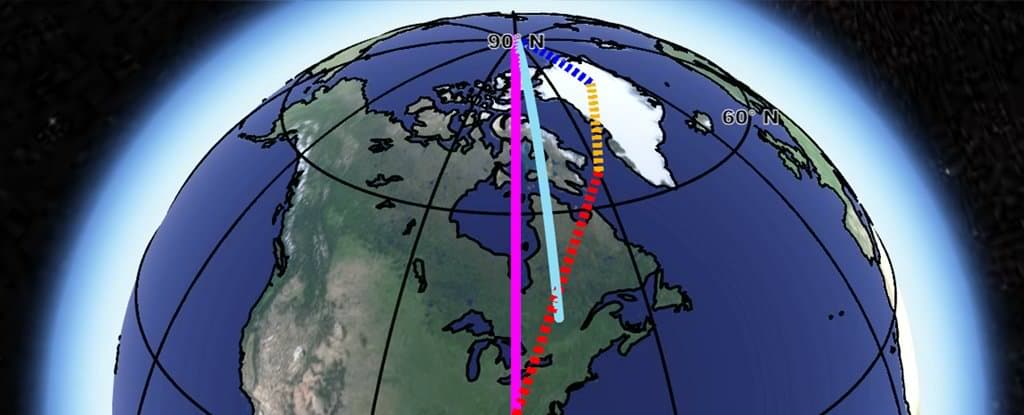
NASA scientists have combined data on our planet’s rotation with a number of sophisticated models to find that melting ice is a major cause of a strange drift in our planet’s wobbling spin.
Yes, our love of fossil fuels hasn’t just given Earth an extra blanket, it’s literally throwing the entire globe off balance. The blame isn’t entirely on our shoulders, though – they also found the sloshing of molten rock deep beneath our feet plays a significant role.
The idea that the redistribution of water – from chunks of ice on land to liquid in the ocean – is affecting how our planet rotates on its axis isn’t new. In fact, it’s been the primary explanation of our planet’s increasing wobble for a few years now.
But researchers haven’t been convinced it’s the whole story.
So a study led by NASA piled up a century’s worth of data on planetary rotation, sea level changes, and continental mass changes, and analysed it alongside the latest models on the steady flow of molten rock far beneath Earth’s crust.
“The traditional explanation is that one process, glacial rebound, is responsible for this motion of Earth’s spin axis,” says the study’s first author Surendra Adhikari from NASA’s Jet Propulsion Laboratory in California.
“But recently, many researchers have speculated that other processes could have potentially large effects on it as well.”
We all agree – well, most of us – that our planet is a giant ball that spins around a central point running from pole-to-pole, completing a single rotation every 24 hours.
A more accurate description is our planet is a slightly lumpy, roughly spherically-shaped, slightly-squished sphere that spins on an axis once every 23 hours, 56 minutes, and 4 seconds.
Thanks to factors like its imperfect shape, uneven distribution of mass, and the nudging of our planet by other objects in our Solar System, it doesn’t spin neatly on its axis once a day. It draws a circle, like a top about to fall.
The precise position of this off-centre spin axis also changes, making the planet ‘wobble’ over every six to 14 years.
Over the past century, that wobble has largely drifted west at a pace of 10.5 centimetres (4 inches) a year, changing its location by about 10 metres.
But the path it takes isn’t a neat one. Around the turn of the millennium, the drifting spin axis dog-legged back unexpectedly at a pace of about 17 (7 inches) centimetres a year.
Those zig-zagging numbers might not seem big, but they do point to some impressive geological forces.
Naturally, ice loss is prime suspect number one. Greenland alone has lost some 7,500 gigatons – think 20 million skyscrapers – of ice over the past 100 years.
Without the burden of a heavy layer of frost, the crust beneath relaxes and rises up. Like a spinning ballerina throwing out an arm, the change in shape nudges the planet’s wobble move into a new direction.
This has no doubt worsened thanks to global warming, but it’s also an incredibly slow process, one that has also been gradually taking place ever since the end of the last great Ice Age.
For a bigger picture of the 20th century’s migrating axis, we need to combine data on the planet’s dynamics to see if there isn’t something else going on. Which means taking into account its churning guts.
“We assembled models for a suite of processes that are thought to be important for driving the motion of the spin axis,” says Adhikari.
It turns out that the slow rising of the planet’s crust after the last Ice Age only accounts for about a third of the spin axis’s drift; but we’re not entirely off the hook.
The researchers think the remaining two thirds comes from two other sources, one being the even redistribution of mass in the form of rising sea levels.
“We identified not one but three sets of processes that are crucial – and melting of the global cryosphere (especially Greenland) over the course of the 20th century is one of them,” says Adhikari.
Above: The observed direction of polar motion, shown as a light blue line, compared with the sum (pink line) of the influence of Greenland ice loss (blue), post-glacial rebound (yellow) and deep mantle convection (red).
The rest is all down to convection currents slowly pushing clumps of hot, gooey rock through the mantle. We don’t know enough about Earth’s core to have a clear picture of this process, other than it seems to neatly fill in the blanks. Improved data from seismic surveys will help provide better models.
There’s still plenty to learn about our planet’s drifting wobble. But it’s a sobering thought that human activity has had an impact on how our world turns.


